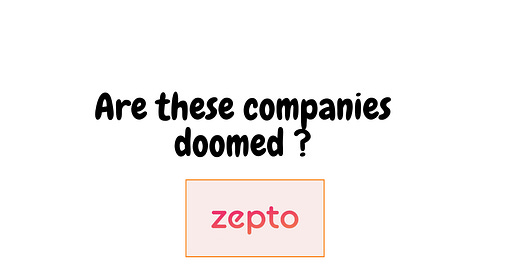Blog #6 Is Quick Commerce really doomed to fail due to unit economics ?
Understanding the A to Z of quick commerce product & unit economics
Quick Commerce, or Q-commerce, has been one of the biggest innovations that emerged during the COVID era. With the promise of delivering products within 10 minutes, Q-commerce has disrupted the entire hyperlocal delivery space, making companies rethink their business models. However, the industry has been labeled as a cash-burning entity without any reasonable direction in sight. But is it really doomed to fail due to economics? I have worked at Swiggy, had a chance to analyze Zomato’s shareholder report, and talked to folks at Zepto to understand the key metrics of sustainability for Quick Commerce.
User Metrics
Zepto does roughly close to 0.3 million orders a day with Instamart & Blinkit doing similar numbers.
Average Monthly Repeat Rate = 8
This denotes a very high-frequency use case and corresponds with the real-world grocery/f&v buying categories and also denotes a very high capture of the customer wallet share for this use case. This also is a measure of customer stickiness.
These are some of the most healthy numbers for any startup in the commerce category denoting that no matter what consumers love Q-commerce. If something is solving for the consumer, then a viable business can always be made.
6 months retention ~ 30-35%
A higher monthly repeat rate leads to more retention.
Share of Repeat user orders = 80-85%
This represents that the company is not dependent solely on new user acquisition and is in a very healthy state as a result of doing new user acquisition in the past and high retention of these users leading to a high share of repeat orders. Better retention leads to a higher share of repeat orders over a period of time.
Unit Economics
With such wonderful consumer retention and stickiness, these companies need to optimize the unit economics to make a sustainable business. The way to improve unit economics is to increase revenue and reduce costs. Let’s take a look at the costs.
Average Order value = 400
Revenue
1. Commissions
On average FMCG+Commodities account for 75% of the average order value and F&V accounts for 25% of the average order value.
Commissions on FMCG+Commodities = 8% (this is due to the high buying power of these companies and they can bypass distributors and directly source from brands)
Commissions on F&V (Fruits vegetables and fresh items like dairy) = 30% (Direct sourcing from farmers and high commission on this due to non-standard prices)
Commission Revenue =(75% *8% +25% *30%)*400 = 54
Future Prospect - With the introduction of white-label commodities such as dal, rice, and larger volumes the margins on FMCG will go up to 12-13%, and due to better demand management & sourcing wastage on F&V will reduce and the margin will go up to 40%.
2. Ads Revenue
FMCG companies traditionally have been one of the largest ad spenders in the world. In quick commerce, they can do both branding and performance advertising. Quick commerce has outperformed food delivery and is competing with e-commerce on the level of advertising.
Unit Ad Revenue = 4% of AOV = 16
Future Prospect
With more eyeballs and deep penetration into the ads market, this number of 4% of AOV ad spend will increase to 5-6% due to deeper competition between legacy and D2C brands.
3. Delivery fee
In order to increase customer conversion and adoption delivery fee has been slashed as a temporary measure.
Average Delivery fee per order = 5
This number will increase further as consumers are more habituated to the service and also a subscription program for free deliveries will further increase delivery fee revenue. Think of the delivery fee charged by food delivery players
Future Prospect = 15
Costs
1. Cost per delivery
The relative cost per delivery of Q commerce would be lower than that of food delivery due to less wait time at the warehouse and closer customers leading to a shorter last mile. This allows delivery partners to do more orders per hour and hence earn more.
Average cost per delivery = 50
This may not significantly decrease.
2. Customer Experience & Refund costs
These are costs related to fraud, customer refunds, and the cost of chat support agents.
Average customer experience = 5
This will further go down with better fraud rules and the use of AI for customer support.
3. Customer Discounts
Discounts are given to consumers to improve conversion. Since the pricing is controlled by the Q-commerce player, it is easy to optimize conversion and reduce the customer discounts
Customer Discounts per order = 10
4. Warehouse & Packaging Costs
With the increase in order density and time, the warehouse costs will go down as storage will become more efficient, and fixed costs of the warehouse will be distributed over time.
Warehouse & packaging cost per order = 15
Summary
Unit Revenue = Commission + Ad revenue + Delivery fee = 54+16+5= 75
Unit Costs = Cost per delivery + Warehouse & packaging cost + customer discount + CX costs = 50+15+10+5 = 80
Unit Economics = 75-80 = -5
The current unit economics may be slightly negative but the future prospects are very bright and within a year these companies will have a positive unit economics of 10+.





Hi, I had a question: Zepto claims they do 3L orders a day, so 10Cr orders a year. They booked 2000Cr revenue for the prev FY. This means they're making a revenue of 200 per order with AOV 400-450. This deviates from your value of 75. Am I missing something here? Since 200 seems rather high, I'd err towards your calculation of 75, but would still like a reconciliation between the two numbers.